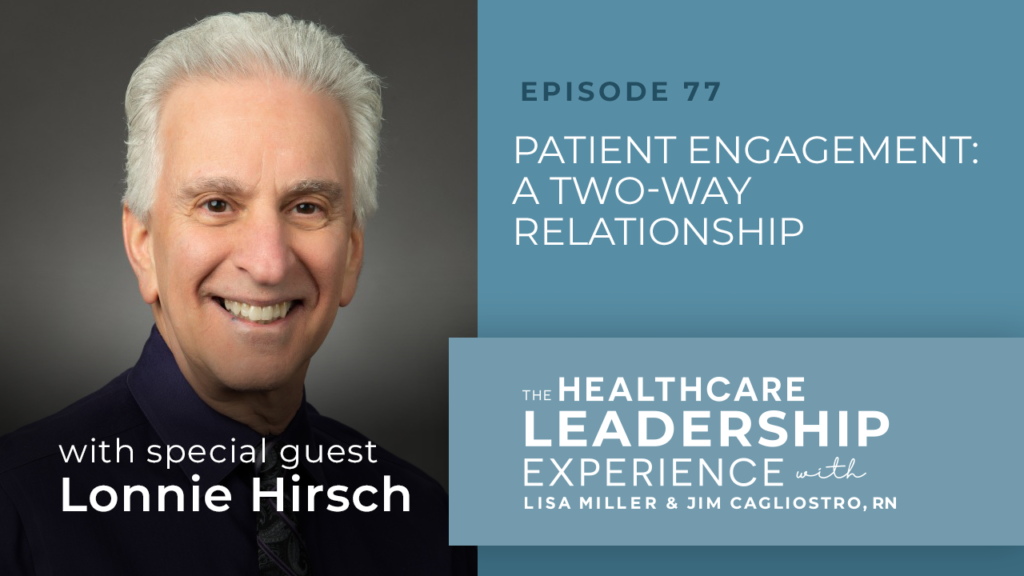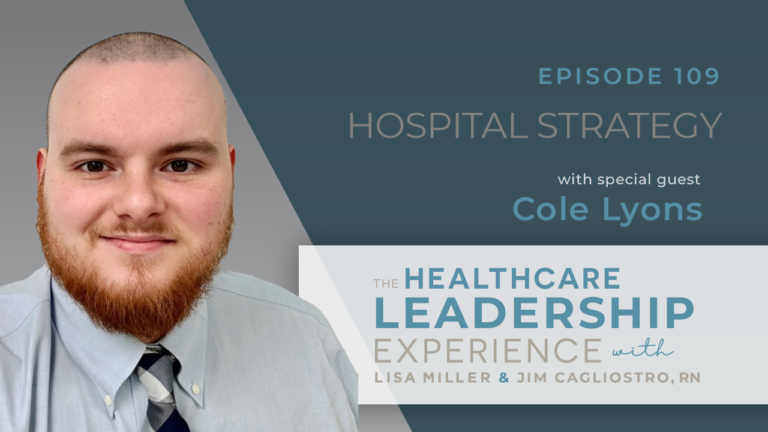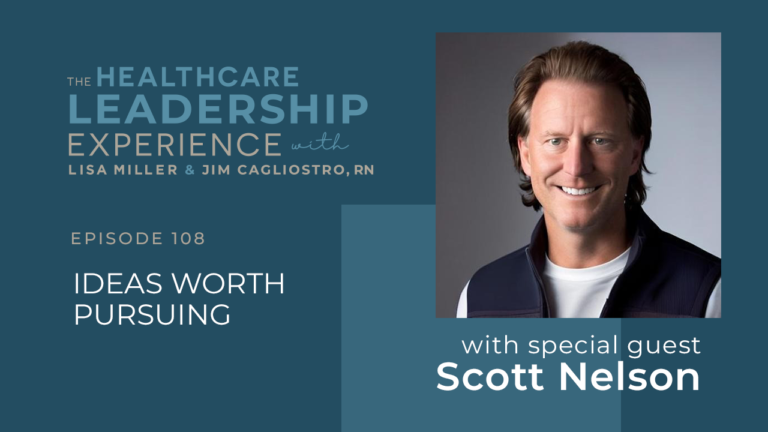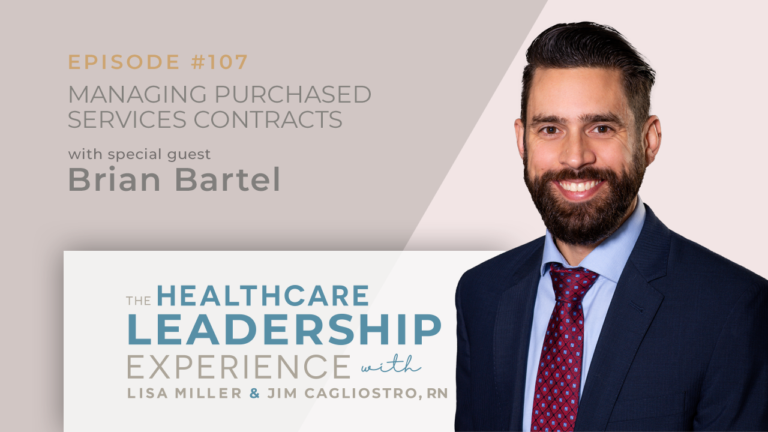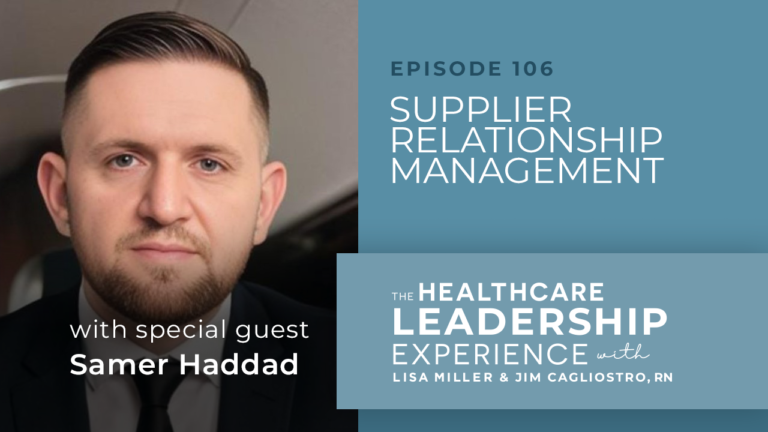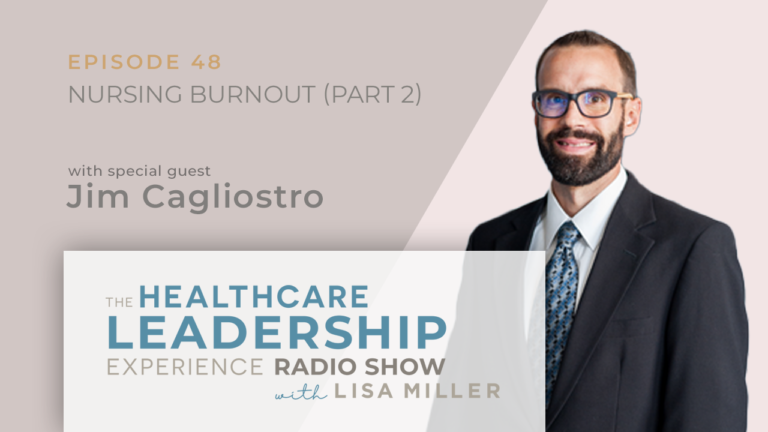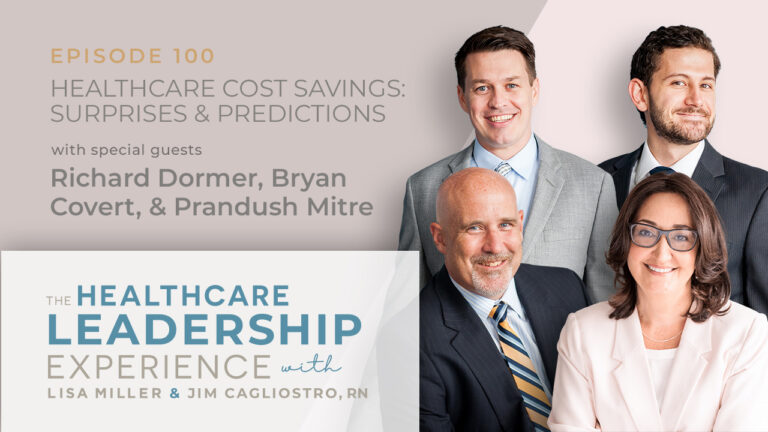Episode Introduction
Lonnie shares the ‘’three lacks’’ that get in the way of effective patient engagement, why patients must be empowered to take ownership of their own health journeys, and reminds us that, while healthcare is episodic, health is a constant. He also explains why patient engagement is not a marketing issue, why its highest purpose is outcomes, and the need for hospitals to ‘’care for the people who care for their patients.’’
Show Topics
- Strengthening relationships between patients and healthcare providers
- The ‘’three lacks’’ in patient engagement
- Effective marketing is a one-on-one conversation
- Patient engagement begins with trust
- The highest purpose of patient engagement is outcomes
- Understanding the emotional weight on your customers
04:26 Strengthening relationships between patients and healthcare providers
Lonnie outlined his motivation for focusing on patient engagement.
‘’Certainly, what gets me going is anything that contributes to solving the challenges that are standing in the way of more people having more awareness and access to affordable, high quality healthcare. That’s a big deal, and it’s become an increasingly more important focus for me is how can I help, how can Forefront help with that message and that connection? Secondly, I’d say anything that helps people navigate the really cumbersome healthcare, I call it a labyrinth. Many people find the whole experience of trying to navigate their healthcare to be enormously confusing, convoluted, maddening, mystifying, certainly, very frustrating. So those issues are very important to me and increasingly a priority focus. I’m also big into educating and empowering more people on ways they can live healthier lives and avoid preventable disease. And if I had to name one other thing that gets me going in the morning, I’d say it’s building or strengthening relationships between patients and the healthcare professionals who are providing their care.’’
09:09 The ‘’three lacks’’ in patient engagement
Lonnie outlined three key reasons why healthcare misses the mark with patient engagement. ‘’
‘’And there are three that I would put in that category of what I call lacks. I’ll explain what I mean by that. The first is the lack of enough time for healthcare providers to interact meaningfully with their patients. And if I had to prioritize the challenges for better patient engagement, that would probably be at the top of the list. But close behind would be the lack of belief and trust by the patients based on their experience that the people trying to get them to engage, really know them. Understand them as individuals understand their concerns, their fears, their motivations, and frankly, really care about them. It’s hard because there’s so many people that need the help and organizations that are providing that care are under a lot of time pressure, which goes back to my first lack. But that issue of a patient not really believing that anyone in the organization really knows them or even cares to know them is a big challenge in terms of getting patients to engage. And the third lack that I would prioritize is the lack of human interaction between episodes of care, not just during them, by the healthcare organizations to make sure that patients understand and feel understood and heard regarding what they can do or need to do to improve their health and live healthier lives. Not just when they’re sick or feeling poorly, but at all times.’’
13:19 Effective marketing is a one-on-one conversation
Lonnie said that a personalized approach is needed to overcome barriers around issues such as language, traditions, and education.
‘’…But I would say that the cultural issues are the biggest challenge, and that’s because what we call culture really includes language, meaning, someone’s first language, education, family history and traditions, people’s biases and beliefs. All of that really goes into culture. And that obviously requires a very personalized approach that isn’t easy to scale or automate as we were talking about. You can automate text-based communications based on things like the primary language of the patient, but the other cultural influences are really much harder to scale. And again, it goes back to what I said before about effective engagement, requiring the patient to be and feel understood and cared about as an individual. ….when you’re effectively marketing, you are really having a one-on-one conversation with someone else, even if that message is going out to thousands or tens of thousands of people at the same time. And increasingly more of the marketing is being more personalized as well, if you will, according to individuals or smaller cohorts. But if it isn’t a one-to-one conversation, it’s not going to resonate with the patient and just makes the effort to get more engagement, more difficult.’’
16:15 Patient engagement begins with trust
Lonnie said that healthcare providers don’t offer the time required to build trust with their patients.
‘’…this really goes to the heart of patient engagement or the challenges when engagement isn’t happening. Because at its core, patient engagement is all about trust and all about relationships. No relationship, no trust. No trust, no engagement. And the other part is people don’t trust an institution. They don’t trust a hospital or a system. I mean, trust is a human emotion, so you can’t cultivate trust with an entity or an organization. The trust is between people. So patients are only going to trust people who they believe understand and care about them. I’m kind of repeating myself here to make a point. But they believe that they have some kind of a connection to somebody or some people who understand them, care about them, and what’s best for them. And I certainly think that most people who are working on patient engagement in healthcare organizations understand that, but they don’t really have good solutions because of this inability to provide the time that’s required to build that trust between the patients and the healthcare clinicians and other professionals who provide their care. Which includes specialists by the way, not just primary care providers. So when you talk about what does a lack of trust look like, it looks like patients who don’t follow through on what is in their treatment plan, patients who don’t take their medications or even fill the prescriptions, patients who don’t respond to attempts to schedule their appointments, patients who express their frustration in other ways. In most cases, it’s passive disengagement. It’s not like they’re out there banging on your door or complaining. They’re just not emotionally connected. And so they don’t feel there’s trust, they feel they’re on their own, they access the care they need the best way they can figure out how to access it when they need it. But there’s no relationship, so there’s no trust.’’
22:15 The highest purpose of patient engagement is outcomes
Lonnie said measuring outcomes is a more important metric than surveys, appointments, and medications.
‘’…. If a patient is engaged, you’re going to see it in the outcomes. You’re going to see it in medication adherence going up. You’re going to see it in health improvements related to the treatments. You’re going to see it in follow through on their scheduling their colonoscopies or their mammograms or their prostate checks. You’re going to see it in reduced A1C levels or reduced triglyceride levels. Ultimately, isn’t that the highest purpose of patient engagement? Or at least to me it certainly should be. And as far as assigning or building patient engagement teams or patient engagement leaders, it’s part of the process, but it’s also a trap. I see this happen in healthcare organizations a lot with what is categorized under also patient experience, which is closely related to patient engagement. And a health system will hire a head of patient engagement or maybe a couple of people to lead their patient engagement efforts, and give them that title and that responsibility, but then it becomes kind of an impression that it’s somebody else’s job. “Oh, well, our patient engagement director or our VP of patient engagement or whoever holds the title, they’re the ones who are responsible for moving the needle.” It’s an impossible task and a trap, because patient engagement and patient experience and all of those issues happen at the point of care. So everybody has to be involved in it, or it really doesn’t take hold and it doesn’t resonate.’’
28:20 Understanding the ‘’emotional weight’’ on your customers
Lonnie said healthcare providers can build connections by acknowledging the pressure on their patients.
‘’But you have to remind yourself when you’re in that setting that every patient who’s in front of you is carrying an emotional weight, and they’re bringing that into that encounter. They may show it, they may hide it, but it’s there. And so thinking about this being just, this is my day and this is how many patients we have to see, and this is what we have to get done, and this is the documentation we have to provide, and this is the next room that we need to move into for the next patient. Yes, all of that is necessary to have a functional organization. But when you lose the perspective on the emotional weight that customers, and I’m going to call patients’ customers here, bring into each encounter, you’re losing the chance to have that connection. You’re losing the chance to build trust. You’re losing the chance to have patients want to engage, want to take more ownership in their own health, want to feel like you are on their side. And I’m not saying it’s easy, but I see it all the time. I understand it, and it’s a big challenge in terms of this whole topic of why patients don’t do what they really should do, even if they understand the reasons that they should do it.’’
Show Links
Connect with Lisa Miller on LinkedIn
Connect with Jim Cagliostro on LinkedIn
Connect with Lonnie Hirsch on LinkedIn
Check out VIE Healthcare and SpendMend
You’ll also hear:
Lonnie’s definition of patient engagement: ‘’…patient engagement is about empowering patients to actively take ownership of their own health journeys and supported by and in collaboration with their care providers. And to have access to the information and resources that enable patients and their loved ones to be and feel more in control of their health and healthcare.‘’
Healthcare is episodic, but health is a constant. Why healthcare organizations need to be part of a patient’s lifelong journey to increase engagement.
Why patient engagement is not a marketing issue: ‘’Even though that’s often where patient engagement initiatives land, patient engagement is a relationship issue between individuals and their care teams. If you don’t solve for that, all the best marketing tactics and communications won’t really move the needle.’’
Patient engagement has a business case too: ‘’But if you need a business framework or a business rationale for it, improving patient engagement goes to the financial bottom line and profit line of the organizations as well or doesn’t, depending on whether they’re effective with it or not.’’
Leadership wisdom: Why healthcare providers must prioritize ‘’taking care of the people who take care of your patients.’’
What To Do Next:
- Subscribe to The Economics of Healthcare and receive a special report on 15 Effective Cost Savings Strategies.
- There are three ways to work with VIE Healthcare:
- Benchmark a vendor contract – either an existing contract or a new agreement.
- We can support your team with their cost savings initiatives to add resources and expertise. We set a bold cost savings goal and work together to achieve it.
- VIE can perform a cost savings opportunity assessment. We dig deep into all of your spend and uncover unique areas of cost savings.
- If you are interested in learning more, the quickest way to get your questions answered is to speak with Lisa Miller at lmiller@spendmend.com or directly at 732-319-5700
Episode Transcript
DOWNLOAD THE FULL PDF TRANSCRIPT HERE
CLICK HERE TO OPEN THE FULL TRANSCRIPT
Lonnie (00:00):
This really goes to the heart of patient engagement or the challenges when engagement isn’t happening, because at its core, patient engagement is all about trust and all about relationships. No relationship, no trust. No trust, no engagement.
Introduction (00:18):
Welcome to the Healthcare Leadership Experience podcast, hosted by Lisa Miller and Jim Cagliostro. Lisa is the founder of VIE Healthcare Consulting, and now managing director at SpendMend. Lisa and her team has generated over $1 billion in financial improvements for VIE’s clients since 1999.
Since 2007, Jim has been a registered nurse working in critical care, perioperative services, and outpatient settings at nationally recognized medical facilities across three states.
You’ll hear conversations on relevant and trending topics in healthcare and much more. Now, here’s your hosts, Lisa and Jim.
Jim (00:57):
Hi, this is Jim Cagliostro, and you’re listening to The Healthcare Leadership Experience.
Today’s guest is Lonnie Hirsch, founder and CEO of Forefront Healthcare Consulting. Today, I’ve asked Lonnie to speak about patient engagement, a topic I know that he’s passionate about and one that he recognizes as a huge opportunity for improvement in healthcare today. So Lonnie, thank you and welcome.
Lonnie:
Thank you, Jim. I’m really glad to be here.
Jim (01:20):
I always like to start out with just kind of our audience getting to know you a little bit better. So can you tell us a little about yourself, your experience, your goals, whether personal or professional, and your motivation in terms of as you lead Forefront, what’s your motivation getting up every morning?
Lonnie (01:40):
Well, thanks. That’s a lot to start with. And first-
Jim (01:41):
Sorry.
Lonnie (01:41):
… of all, thank you for inviting me to the conversation. Patient engagement is an area I work on and think about all the time, so it’s exciting to have a chance to talk about it with you.
Jim (01:52):
Great.
Lonnie (01:53):
As far as my background goes, my first job related to the healthcare industry was more than 30 years ago as one of the first employees in a startup healthcare marketing and advertising agency. We served mostly healthcare organizations, and so I was there quite a while, helped build the company, eventually became president. Company was sold, and I left to start my own healthcare marketing agency back in 2006 with a partner. We grew that business for about nine years that I was there to about a $10 million annual revenue at the time I sold my partnership.
Lonnie (02:29):
What changed for me that caused me to kind of rethink what I wanted to do next with my career and focus on other things than just the healthcare marketing category is as I worked with more and more organizations, I became increasingly more interested in why patients are frustrated with their healthcare experience, and why healthcare organizations struggle to develop meaningful connections with their patients.
Jim (02:57):
Sure.
Lonnie (02:58):
I was also interested in why patients often don’t do what’s in their best health interest, and why doctors, nurses, other healthcare professionals seem to find it challenging to gain the trust of their patients and convince them to take the actions that are important for them to improve their health. And those aren’t areas where marketing agencies are usually invited to play.
I felt drawn to those kinds of issues. I was always interested in healthcare innovations, any innovations that affect patients or their experiences or the entire lifetime health journey of people. And so when I sold my agency, I really just started doing some consulting projects with healthcare organizations that wanted more insights or more guidance in those areas. And it just kind of grew into more of a consulting group.
Lonnie (03:57):
Forefront is not a traditional consulting group in the sense that you’d think of a lot of consultants that are all employees of a company and go out and help organizations. It’s really more about a consortium of independent healthcare consultants. So that’s what I’m working on these days.
As far as what makes me get up in the morning, there’s a lot that keeps me going all day long. I guess I’ll name a few that come to mind.
Jim (04:25):
Please.
Lonnie (04:26):
Certainly, what gets me going is anything that contributes to solving the challenges that are standing in the way of more people having more awareness and access to affordable, high-quality healthcare. That’s a big deal, and it’s become an increasingly more important focus for me is how can I help, how can Forefront help with that message and that connection?
Lonnie (04:55):
Secondly, I’d say anything that helps people navigate the really cumbersome healthcare, I call it a labyrinth. Many people find the whole experience of trying to navigate their healthcare to be enormously confusing, convoluted, maddening, mystifying, certainly, very frustrating. So those issues are very important to me and increasingly a priority focus. I’m also big into educating and empowering more people on ways they can live healthier lives and avoid preventable disease.
And if I had to name one other thing that gets me going in the morning, I’d say it’s building or strengthening relationships between patients and the healthcare professionals who are providing their care.
Jim (05:45):
I love it, Lonnie. And relationships, that’s a big one for me. And I was just talking to someone the other day about the frustration was the word that I often bring up when we talk about navigating, especially for elderly patients. I mean, I think I’m helping my parents figure out medications and appointments in the patient portal, and it’s frustrating for them. Some of these things are frustrating for me.
But I appreciate you also sharing. We’ve seen this with many of our guests. The background that you come with, isn’t necessarily, you didn’t go through school or start as a young person saying, “I want to be involved in this type of work,” but you come from a marketing background. But that gives you a unique perspective. Like you said, you felt like something was missing or you were wanting more, and I really appreciate you sharing that part of your journey. You come to the table with a different perspective than maybe some other consultants might.
Lonnie (06:31):
Well, I haven’t worked as an employee inside a healthcare organization, but I’ve worked with so many. And I have been on the inside, even if not employed by them in a way that is really eye opening. And so I found that a lot of organizations tend to be pretty insular, so they may not get enough outside perspective, whether it’s from their own patients or from other business people or from other sources than their own team. And that objectivity is really important, particularly in marketing, but really important for, I think, the growth of any successful organization.
Jim (07:14):
Sure, so valuable. So when we talk about patient engagement, now, can you define it? From your perspective, how do you define patient engagement? And why do you think it should be a priority for healthcare leaders today? What would you say are some of the benefits of prioritizing patient engagement?
Lonnie (07:31):
That’s a great question. I mean, like you and I’m assuming most of your listeners, I’ve read many definitions of patient engagement, so I’ll tell you how I define it. For me, patient engagement is about empowering patients to actively take ownership of their own health journeys and supported by and in collaboration with their care providers. And to have access to the information and resources that enable patients and their loved ones to be and feel more in control of their health and healthcare. I know that’s a mouthful, but it’s really-
Jim (08:10):
That’s great.
Lonnie (08:11):
… about, engagement is more than just a one-way conversation.
Jim (08:17):
Wow. That’s great. I love how you added that last part to the access to the information. Again, kind of going back to that frustrating part of the whole navigating the healthcare system. It’s not just that relationship, but having access to the information for whether it’s the patient or the caregivers to continue caring for the patient.
So in your opinion, why do hospitals miss the mark? What are some key barriers or challenges to achieving and maintaining effective patient engagement in healthcare today?
Lonnie (08:49):
Well, first of all, I know there are many dedicated people who work and lead in hospital and health systems that are acutely aware of the challenges. So I’m not going to tell people what they already know in terms of challenges, but I want to focus on the ones that I think are the most significant.
Jim (09:08):
Please.
Lonnie (09:09):
And there are three that I would put in that category of what I call lacks. I’ll explain what I mean by that. The first is the lack of enough time for healthcare providers to interact meaningfully with their patients. And if I had to prioritize the challenges for better patient engagement, that would probably be at the top of the list.
Lonnie (09:34):
But close behind would be the lack of belief and trust by the patients based on their experience that the people trying to get them to engage, really know them. Understand them as individuals understand their concerns, their fears, their motivations, and frankly, really care about them. It’s hard because there’s so many people that need the help and organizations that are providing that care are under a lot of time pressure, which goes back to my first lack. But that issue of a patient not really believing that anyone in the organization really knows them or even cares to know them is a big challenge in terms of getting patients to engage.
And the third lack that I would prioritize is the lack of human interaction between episodes of care, not just during them, by the healthcare organizations to make sure that patients understand and feel understood and heard regarding what they can do or need to do to improve their health and live healthier lives. Not just when they’re sick or feeling poorly, but at all times.
Lonnie (10:49)
I think it’s really important for healthcare organizations to remember that healthcare is episodic, but our health as a constant, it’s all the time kind factor in our lives and our lifelong health journey. And if healthcare organizations want more engagement, they need to be part of that lifelong journey, not just when somebody feels that they need to be seen.
Jim (11:19):
Sure. I love that. So lack of time, lack of belief or trust, and then the lack of human interaction between visits or between episodes. I think those are three great points.
Lonnie (11:30):
Can I make one more point?
Jim (10:30):
Please.
Lonnie (11:31):
It just occurred to me, because I also wanted to make a comment that there are a lot of good efforts that I’m seeing being made to automate aspects of patient engagement to try to fill some of those time gaps.
Jim (11:47):
Sure.
Lonnie (11:48):
But I also noticed that the problem is that patient engagement, and I mean real engagement, is a human experience, and that requires interaction and support from other caring humans. And I am seeing some interesting work being done, for example, with voice recording and analytics that are enabled by AI and machine learning, having that combined with human listeners, if you will, and analyzing those patient conversations to improve understanding of patient’s concerns and the barriers to building trust and behavior changes. And that kind of work really is encouraging. It’s just you can’t lean too heavily on automation or AI in terms of patient engagement because it’s such a human experience.
Jim (12:36):
You’re speaking my language. I’ve been big on that recently, where there’s this big fear that, “Oh, the technology, artificial intelligence, everything is going to replace us.” But no, we should view it as a tool and it’s empowering to the healthcare provider. But we need to use it as a tool, not necessarily see it as a replacement, because then you really do lose that human touch that is essential to healthcare.
Lonnie (12:59):
I couldn’t agree more.
Jim (13:00):
So I want to ask a little more later about the trust and the relationship side of it, but before we get to that, I did want to ask, are there cultural or regional or even generational considerations that must be taken into account when we talk about this concept of patient engagement?
Lonnie (13:19):
Yes, yes, and yes. But I would say that the cultural issues are the biggest challenge, and that’s because what we call culture really includes language, meaning, someone’s first language, education, family history and traditions, people’s biases and beliefs. All of that really goes into culture. And that obviously requires a very personalized approach that isn’t easy to scale or automate as we were talking about.
You can automate text-based communications based on things like the primary language of the patient, but the other cultural influences are really much harder to scale. And again, it goes back to what I said before about effective engagement, requiring the patient to be and feel understood and cared about as an individual.
Jim (15:15):
So I love that you choose that word personalized, that we really are meeting the needs, the desires of that particular patient that we’re caring for in the moment. We can’t just view, “Oh, this is this type of patient.” So yes, there’s standards of care that we want to follow, but seeing each patient as an individual. I love that, the idea of personalizing it to increase patient —
Lonnie (14:34):
Well, that’s kind of a marketing concept as well. And so I guess my thinking is informed by that. Really when you’re effectively marketing, you are really having a one-on-one conversation with someone else, even if that message is going out to thousands or tens of thousands of people at the same time. And increasingly more of the marketing is being more personalized as well, if you will, according to individuals or smaller cohorts. But if it isn’t a one-to-one conversation, it’s not going to resonate with the patient and just makes the effort to get more engagement, more difficult.
Jim (15:15):
Great point. Great point. If you’re just tuning in, you’re listening to the Healthcare Leadership Experience, and I’m your host, Jim Cagliostro.
This show is sponsored by VIE Healthcare Consulting, a SpendMend company, which provides leading edge financial and operational consulting for hospitals, healthcare institutions, and other providers of patient care.
Since 1999, VIE has been a recognized leader in healthcare costs, hospital purchase services, healthcare benchmarking, supply chain management, and performance improvement.
You can learn more about VIE Healthcare Consulting at viehealthcare.com.
Jim (15:51)
Lonnie, I mentioned about continuing that conversation around trust. We hear a lot today that people have lost trust in the healthcare system and maybe that plays out in terms of losing trust in their provider. How important is trust when we talk about patient engagement? Maybe you can share what does a lack of trust look like versus a trusting relationship when we have this idea of patient engagement?
Lonnie (16:15):
Well, I love this question, Jim, because really this really goes to the heart of patient engagement or the challenges when engagement isn’t happening. Because at its core, patient engagement is all about trust and all about relationships. No relationship, no trust. No trust, no engagement.
Lonnie (16:37):
And the other part is people don’t trust an institution. They don’t trust a hospital or a system. I mean, trust is a human emotion, so you can’t cultivate trust with an entity or an organization. The trust is between people. So patients are only going to trust people who they believe understand and care about them. I’m kind of repeating myself here to make a point. But they believe that they have some kind of a connection to somebody or some people who understand them, care about them, and what’s best for them.
Lonnie (17:17):
And I certainly think that most people who are working on patient engagement in healthcare organizations understand that, but they don’t really have good solutions because of this inability to provide the time that’s required to build that trust between the patients and the healthcare clinicians and other professionals who provide their care. Which includes specialists by the way, not just primary care providers. So when you talk about what does a lack of trust look like, it looks like patients who don’t follow through on what is in their treatment plan, patients who don’t take their medications or even fill the prescriptions, patients who don’t respond to attempts to schedule their appointments, patients who express their frustration in other ways.
Lonnie (18:04):
In most cases, it’s passive disengagement. It’s not like they’re out there banging on your door or complaining. They’re just not emotionally connected. And so they don’t feel there’s trust, they feel they’re on their own, they access the care they need the best way they can figure out how to access it when they need it. But there’s no relationship, so there’s no trust.
Jim (18:29):
And then everything you’re laying out there, it is just reinforcing what I’ve read so often in terms of research consistently shows, the better the patient engagement is, the better the outcomes, the better the quality of care. In all those examples that you just mentioned, it’s clear to see why in terms of compliance, in terms of follow-up visits, and making sure that the patient truly is taking ownership. You used that phrase before, taking ownership of their healthcare that’s a huge part of it.
Lonnie (18:56):
So I know you’ve mentioned it already, and we’ve talked previously about your desire to make patient engagement a genuine two-way relationship, not just this one-way where the system or the provider is really pushing out information, but it needs to be a two-way relationship. You’ve answered this some, so I don’t know if you want to add to it, how can healthcare providers really encourage and really facilitate better patient engagement? I think you’ve touched on it, but anything else you’d like to add to that?
Lonnie (19:23):
Well, a couple of points, and one thing I want to start with is reinforcing what you just said. To me, the first requirement is for healthcare organizations to stop thinking that patient engagement is essentially a one-way conversation. Outreach is not engagement. Dialogue is engagement, relationships are engagement, listening is engagement. Patient engagement, actually, and this will sound strange coming from somebody with a marketing background, patient engagement is actually not a marketing issue. Even though that’s often where patient engagement initiatives land, patient engagement is a relationship issue between individuals and their care teams.
Lonnie (20:08):
If you don’t solve for that, all the best marketing tactics and communications won’t really move the needle, certainly not in terms of what we’re talking about when we talk about outcomes. I mean, convincing someone to make an appointment is not patient engagement. It’s a step toward creating the environment where patient engagement can happen. And also because patient engagement is and needs to be a bidirectional relationship, healthcare organizations have to take care of the people who are taking care of their patients. If the providers don’t feel cared for and cared about, there’s almost no chance that patients will feel that from their care teams.
Jim (20:53):
You’re making me think, well, as a father, I can have this approach where I just bark orders at the kids and that’s it. What dad says goes. And okay, maybe sometimes. But it takes work, it takes more time to have this relationship, to listen, like you said, to have this dialogue, but the outcomes are so much better if we take the time, if we’re willing to do the work to have genuine, healthy patient engagement.
I guess I want to go this route and ask how do you think healthcare organizations can measure accurately and evaluate how well they’re doing in terms of patient engagement? Is there maybe additional hires that need to be made, maybe a team that needs to be delegated towards focusing on this? Is there any steps that a health system or hospital can take to measure and improve their patient engagement?
Lonnie (21:45):
Another great question, and there are multiple answers to it, so bear with me. The first one you’re going to know or you should be able to predict what I’m going to say in terms of metrics, how to measure accurately what patient engagement, whether it’s happening or not, and it’s one word, outcomes. I mean, really when you get down to it, that’s the only metric that really should count at the end of the day, not the number of made or kept appointments, not the number of scripts written for medications, not even surveys, outcomes.
Lonnie (22:21):
If a patient is engaged, you’re going to see it in the outcomes. You’re going to see it in medication adherence going up. You’re going to see it in health improvements related to the treatments. You’re going to see it in follow through on their scheduling their colonoscopies or their mammograms or their prostate checks. You’re going to see it in reduced A1C levels or reduced triglyceride levels. Ultimately, isn’t that the highest purpose of patient engagement?
Jim (25:52):
Yes.
Lonnie (22:53):
Or at least to me it certainly should be. And as far as assigning or building patient engagement teams or patient engagement leaders, it’s part of the process, but it’s also a trap. I see this happen in healthcare organizations a lot with what is categorized under also patient experience, which is closely related to patient engagement. And a health system will hire a head of patient engagement or maybe a couple of people to lead their patient engagement efforts, and give them that title and that responsibility, but then it becomes kind of an impression that it’s somebody else’s job. Oh, well, our patient engagement director or our VP of patient engagement or whoever holds the title, they’re the ones who are responsible for moving the needle.
Lonnie (23:51):
It’s an impossible task and a trap, because patient engagement and patient experience and all of those issues happen at the point of care. So everybody has to be involved in it, or it really doesn’t take hold and it doesn’t resonate. You can have leaders that kind of help organize the strategies or look at the processes and collaborate with teams who are providing the care in looking at things that could be changed to improve or enhance patient engagement or patient experience.
Lonnie (24:26):
But if you’re just assigning it, giving somebody a title so that I don’t have to think about it and I also have someone to blame, if we’re not seeing improvement, then you’re going to get the outcome in terms of the lack of improved patient engagement that you should be able to have expected. But beyond that, I’d also want to make a point that there’s a strong case to be made on the financial side of the ledger for cost savings to hospitals and health systems directly related to improved health outcomes for patients.
Lonnie (25:00):
They know that. Everybody who’s listening into this interview knows that. And there’s also a direct line between improved outcomes and market share related to patient satisfaction, endorsement, choice. And that’s for all of us, and I’m speaking as a healthcare consumer now. It isn’t just about doing the right thing, I think that’s the most important reason. But if you need a business framework or a business rationale for it, improve patient engagement goes to the financial bottom line and profit line of the organizations as well or doesn’t, depending on whether they’re effective with it or not.
Jim (25:41):
So there are multiple benefits to prioritizing patient engagement, and you just named them right there. And I really appreciate what you said about it’s really each person within the organization taking responsibility to prioritize patient engagement. I know I’ve personally, again, as a healthcare consumer, I’ve been to doctors’ offices where the person at the front desk will hand you a piece of paper, “Here’s our patient portal.” “Okay, great.”
As opposed to every individual, the doctor, the nurse that’s checking you in, the person at the front desk says, not just, “Here’s a paper that talks about our patient portal,” but, “Hey, we want to hear from you within a week. Hey, if you go on here, you can see your lab results.” And really kind of walking you through and creating this atmosphere of this is going to be an ongoing relationship. It’s not just a one-time visit. “Okay, we’ll see you in six months.” I think you hit some great points right there.
Lonnie (26:31):
Well, you’re bringing up something else in my mind that it wasn’t one of your questions directly, but I want to add a comment here.
Jim (26:36):
Please.
Lonnie (26:37):
One of the things that’s really, really challenging about working in healthcare, particularly, inside healthcare organizations is that to the people who work there every day, it’s a job. It becomes more of a job, maybe either more fulfilling or more frustrating depending on that individual and what they’re experiencing. But the stakes for the customer, if you think about the patients as customers in terms of a business context, the stake for the customer is high every time they come in.
Lonnie (27:16):
They’re there for a reason. They’re usually there either for a concern or in unfortunately two rare cases, being proactive to make sure they’re maintaining good health, but they’re bringing a fair amount of emotion many times into the environment. And so when you work in healthcare every day, you start to protect yourself emotionally from getting too involved with the emotions of your customers-
Jim (27:49):
Right, agreed.
Lonnie (27:50):
… because it’s exhausting, it’s frustrating, it’s very challenging. So I know certainly providers of care, the actual direct clinicians, the doctors, the nurses, the surgeons many times, whether they’re conscious of it or not, they are emotionally removing themselves a step back, so that they don’t get too caught up in that issue. Because they just don’t feel that they’re going to be able to function professionally and well if they allow that.
Lonnie (28:20):
But you have to remind yourself when you’re in that setting that every patient who’s in front of you is carrying an emotional weight, and they’re bringing that into that encounter. They may show it, they may hide it, but it’s there. And so thinking about this being just, this is my day, and this is how many patients we have to see, and this is what we have to get done, and this is the documentation we have to provide, and this is the next room that we need to move into for the next patient.
Lonnie (28:56):
Yes, all of that is necessary to have a functional organization. But when you lose the perspective on the emotional weight that customers, and I’m going to call patients’ customers here, bring into each encounter, you’re losing the chance to have that connection. You’re losing the chance to build trust. You’re losing the chance to have patients want to engage, want to take more ownership in their own health, want to feel like you are on their side. And I’m not saying it’s easy, but I see it all the time. I understand it, and it’s a big challenge in terms of this whole topic of why patients don’t do what they really should do, even if they understand the reasons that they should do it.
Jim (29:49):
I love that Lonnie. And when you speak, you can see the experience and the time that you’ve had in the healthcare industry, and I really appreciate you bringing even that last point. I think that’s great for our listeners to hear.
So in wrapping up here, I always like to give our guests a chance to share some leadership wisdom. So maybe it doesn’t necessarily have to be about patient engagement, but maybe something that you’ve learned or some insight that has really enabled you to continue to have an impact in today’s healthcare landscape. Any parting words that you’d like to leave with our audience? Any words of wisdom in terms of leadership?
Lonnie (30:26):
Well, I have been doing this a long time, so whatever “wisdom,” and I’m putting that in quotes, that I’ve acquired has been slow and gradual and hopefully will continue for as long as I’m able to contribute. But what I would say to anyone listening who works in a hospital or health system setting is that you have to prioritize every way you can, and I know this isn’t easy, but prioritizing every way you can to allow more time for building relationships and trust between your patients and your providers of care, and prioritizing taking care of the people who take care of your patients.
Lonnie (31:06):
Because if you really plan to foster an environment where true patient engagement and improved health outcomes can flourish, that’s essential. And that’s really what I focus on almost every day. I mean, there’s a lot going on at Forefront, but it’s a big part of my personal journey is trying to help strengthen that connection so that… Because I come at it, I put myself in the role of the patient, in the role of the healthcare consumer at, which we all are, including all of you who work in healthcare organizations, so when I come at it from that perspective, it’s hard not to be passionate about it.
Jim (31:51):
It’s clearly not just a job for you, and I love that you are sharing your personal experience and your heart for what you do. Thank you, Lonnie. Thank you for sharing that.
Thank you for being on the show and thank you to our listeners who spent time with us today.
If you have any questions about VIE Healthcare Consulting, a SpendMend company, or if you want to reach out to me or Lisa Miller, you can find us on LinkedIn. And Lonnie is also on LinkedIn, you’ll find them there.
We at VIE love helping hospitals save money and enhance the patient experience and patient engagement. And we’re hoping that the episode today gave you some new insight or ideas to consider and use in your career and your own healthcare organization.
Lonnie, once again, thank you. Thank you for your time today,
Lonnie (32:33):
Jim, thank you for inviting me. I really enjoyed it.
Speaker (32:37_:
Thanks for listening to The Healthcare Leadership Experience Podcast. We hope you’ve enjoyed this episode. If you’re interested in learning new strategies, best practices, and ideas to utilize in your career and healthcare organization, check out our website at the healthcareleadershipexperience.com. And oh, yeah, don’t forget to rate and review us. And be sure to join Lisa and Jim next time on The Healthcare Leadership Experience Podcast. Thanks again for listening.
